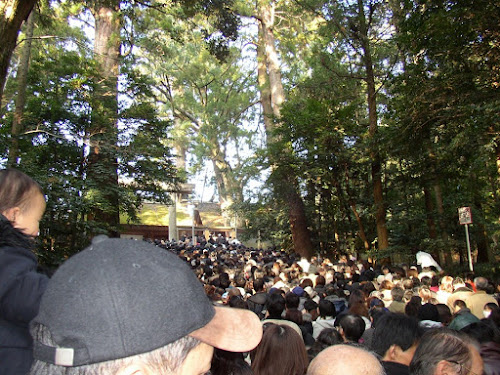Travel to Ise Shrine、伊勢への旅
10th November in Ise、11月10日、伊勢国、山田にて
 |
| Todaiji Temple in Nara、東大寺大仏殿 |
She
went to Ise Shrine with her female companion by rickshaw via Nara which was an
old capital. It was ten-day trip. She praised the landscape.
Three
runners of rickshaws asked her to hire them, because they themselves wanted to go to Ise.
They were farmers, however it was written that they would hand over farming to
their wives during the off-season of agriculture and worked as rickshaw pullers.
They wanted to visit Ise Shrine and buy talismans for their neighbors. The runners said that half of their earnings were spent on buying talismans and souvenirs.
Moreover, they bought toys for children, so there were a lot of toys on their
rickshaws. The souvenirs are fun for both of senders and receivers.
By
the way, the fare depended on the distance, so they worked hard.
 |
Old toys at Shitamachi Museum
|
 |
| Souvenir shop in Asakusa、浅草仲見世の小山商店 |
She admired Hasadera temple, went through Matsuzaka which is a very famous place for its Wagu-beef, and arrived at Yamada where is the shrine town in Ise. She wrote that Yamada was the most beautiful town in Japan, however, she also wrote; religion and prostitution existed together apparently. Most of the great shrines which gathered pilgrims were surrounded by entertainment districts where immoral people gathered. She added that the street, which linked two important shrines in Ise, was the typical entertainment district. I cannot deny that going to shrines and temples are entertainment for most of Japanese even now.
 |
| Ise Shrine on the New Year's Day、元日の伊勢神宮内宮 |
イザベラは、西洋人の女友達とともに人力車で奈良を経由し伊勢神宮に行く。途中の風景も、「すばらしい風景の連続だった」と愛でている。
奈良を過ぎた三輪の宿で、三人の車夫(ランナー)たちが伊勢を回って京都に戻る10日間の旅に自分たちを雇って欲しいと頼む。その理由が、伊勢にお参りに行きたいということ。車夫たちは農夫で、
「農閑期には農地の世話を妻に任せて、人力車を引く仕事をしている。行く先々で子供たちのために玩具を買うので、人力車のくぼんだ隙間は玩具であふれている。それで、『お伊勢参り』をし、知り合いや近所の人にたくさんのお守りを買うことができた暁には、喜び勇んで家路につくことになると思われた。彼らが言うには、その日の距離によって違うが、40~60銭になる稼ぎのうち20銭をこのようなために使うとのことだった。」とある。お土産は、贈る方にとっても大きな楽しみだったのだ。なお、稼ぎは距離で決まるので、彼らはイザベラに十分尽くす。
長谷寺を愛で、名張、青山、松阪を経て、山田に着く。「この山田ほど美しく立派な町を日本で目にしたことはなかった」とあるが、「この国では売春と宗教が外観上は共存していることが多い。巡礼者が訪れる大きな神社はほとんどの場合、ふしだらな人間が集まる遊所で囲まれている。外宮と内宮を結ぶ立派な通りほどこれらがうんざりするほど多いところは他にない」とある。イザベラがすでに書いているように、「私がこれまでに会ってきた国民のうちで日本人ほど信仰心のない国民はいない。寺社詣でと言っても行楽であるし、宗教に関わる祭りといっても縁日に過ぎない」という一面は、今でもあると思う。御朱印集めもその一例かも知れない。
15th
November in Otsu, Lake Biwako、11月15日、琵琶湖、大津にて
She traveled anther route to return to Kobe
and reached Otsu near Kyoto.
 |
| Old temple Miidera in Otsu、三井寺 |
She stayed at Otsu and saw Otsu festival. It
is a gorgeous festival, so many people come to see it.
 |
| Otsu festival @ Otsu festival pavilion 大津曳山展示館 |
She went out in evening and mentioned that the
streets were filled with lights and colors, it seemed like a fairyland. The
houses facing the street opened their doors. People could see various things such
as a gorgeous folding screen inside the houses. Residents competed the beauty
of their valuables with their neighbors. Tableau vivants were also shown. Many
visitors walked along the street gently. It was interesting for me that people
enjoyed without making a fuss.
Reference:
Streets in Otsu and many photos of the festival are uploaded here:
https://4travel.jp/travelogue/10940668
At the corners, many lanterns were
hung on the stands which were 25 feet high. The floats were 20 feet high, and
ten boys played music on the top with drums and wood flutes. She wrote that the
sound was very obnoxious which seemed to be the Devil’s music.
Reference:
Music of Otsu festival, I like.
She wrote; there were many stands in the
shrines. Dressed pretty children like dolls bought many toys which were
different from Christians’ one. It must be a good day for children.
She wrote; Many people gathered in the Inari
Shrine. The main hall and dancing hall were lighted up. Dressed up people
rushed there, they bought, sold, laughed, sang and played instruments. It was
so bustling, however the peak hour was 10pm, people returned home or inns soon
when it started raining. I thought young people enjoyed all night.
Residents
pulled floats next day.
Reference:
NPO of Otsu festival http://www.otsu-matsuri.jp/home/
津、関、鈴鹿、土山を経て大津に至る。
「---湖面は白帆に染まり、小型蒸気船による輸送も活発に行われている。琵琶湖は娯楽を求める人の一大行楽地であり、茶屋も名を馳せている。」とし、僧侶の山の比叡山、僧侶の村の坂本、三井寺、石山寺を名所として挙げている。
大津では、大津祭のタイミングで宿泊する。
大津祭は華やかな祭りで、近隣からも人が押し寄せ、宿屋も込み合い、やっと一部屋確保したという。まず、町の記述から入る。
「---通りはどこも光と色があざやかで、---、辺り一面はまるでおとぎの国のようだった。」
襖を取り払った家では、道に面して、屏風や敷物、豪華な飾り物などを置き、床の間には菊を飾る。座敷では、
「二、三人の知り合いが一緒に煙草を燻らしたり茶をすすったりしていた。見てすぐにわかったが、彼らはめいめいが通りに面して披露した飾り物の美しさを競い合っていたのである。--- 大変な数の人々が、家の正面におかれた、微動だにしないからくりを見比べて称賛しながら、幅の狭い通りを整然と静かに歩を進めていた。」
これは人の楽しみだが、その後に記載される境内と違って、静かに楽しんでいるところが面白い。
参照:大津祭時の町並みをはじめ沢山の写真がアップロードされています 。
https://4travel.jp/travelogue/10940668
通りの角=辻には、25フィート(7.6m)の高さに組んだ大吊り提灯が飾られている。また、高さ20フィート(6m)の曳山には10人の少年がいて、太鼓や鉦をたたき、笛を吹いているが、イザベラは、「不愉快この上ない悪魔のような音だった」とのこと。
大津祭のお囃子の動画、私にはいい感じです。
https://www.youtube.com/watch?v=mf8qGadUbG0
神社の境内には露店が並び、「蜜柑や柿や、キリスト教徒のものとは違うありとあらゆる玩具が、着飾った人形のような可愛い子供たちに飛ぶように売られていた。」とある。子供を大事にしている。
「人が最も集まっているのは稲荷社で、色とりどりの淡い光に包まれた本殿と舞殿の周りには晴れ着姿の老若男女が押し寄せ、物を買ったり、売ったり、笑ったり、歌を唄ったり、鉦を叩いたり、笛を吹いたりする音があふれていた。」とあり、大賑わいだ。でも、10時頃がピークで、雨が降り出した途端、人は居なくなったということ。若者は朝まで騒ぐのかと思ったが。
翌11月16日は、曳山となる。
参照:大津祭曳山連盟 http://www.otsu-matsuri.jp/home/
At
the end of the trip、旅の終わり
She mentioned security was well
maintained in Japan. They could travel around 200 miles without vales in the
rural area where almost no European women would go. They had never encountered
robbery and other untoward incidents. This region was peaceful and well maintained.
We were treated politely and kindly, indeed.
She wrote similar matters about northern Japan. Although I understand British government secured her, I am
happy to read her comments about security in Japan. But, I must say, there were
bandits or knights of roads at that time, so it was not absolutely but
relatively safe.
10日間の旅の最後には、「外国の女性二人が、一部を除けばヨーロッパ人の女性などめったに見かけないような地域を、一人の従者もつけないで200マイル近くに及ぶ旅ができ、ただの一度も、強奪にも無礼な仕打ちにも不快な目にもあわなかったのは、この地域の治安がいかに良く平和であり、外国人がそれを享受できるかの証になる。私たちはそんな目にあわなかったどころか、至る所で丁重で親切なもてなしを受けたのであった。」と記している。北関東、東北、北海道でも同様に記述しているが、英国という強いバックがあったとしても、このように記載されているのは、日本人として光栄だ。昔から、追剥などの言葉もあり、泥棒がいたのも事実ではあるが。
Previous
post (Go to the western Japan、西日本へ):
Next post (The
last article about her, departure、イザベラの最終記事・出発):
There are 12 articles about Isabella's travel in Japan. The first page:
イザベラバードの旅は全12ページの記事です。最初の記事は上記のURLです。
Comments
Post a Comment